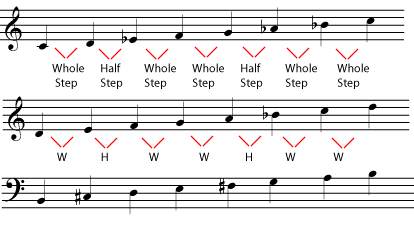
Starting on finger one may take some getting used to, so pay attention. The initial major patterns you've probably already learned and practiced (major scale, major triad, etc.) begin on your second finger. Most of the easier minor scale and chord pattern fingerings begin on your first finger. You will advance more quickly if you always use the exact same fingering. Be very consistent with your fingerings for any scale or pattern you learn. You will want to use one finger per fret to cover the four-fret range. The first fingering to learn for the one octave natural minor scale is fairly easy. We would then say the natural minor scale has a flatted 3rd, flatted 6th, and flatted 7th.Īll scales and patterns can be played many different ways on the bass fretboard. In the natural minor scale the 3rd, 6th, and 7th scale degrees are all a half-step lower than they are in the major scale.


The natural minor scale differs from the notes of the major scale by three notes. Majorįor reference, musicians often talk about scales in how they compare to the major scale. Like the major scale it contains a Root (R), 2nd, 3rd, 4th, 5th, 6th, and 7th. The natural minor scale is a seven-note scale (don’t count the octave). For example, if a song is said to be in the key of G minor it means the song is built using, and revolves around, the notes of the G natural minor scale. When this happens we say the music is in a minor key. Like the major scale, many songs revolve around the notes of the natural minor scale. Melodies in minor keys often use this particular pattern of accidentals, so instrumentalists find it useful to practice melodic minor scales.The natural minor scale is one of music’s most commonly used scales. (Please see Beginning Harmonic Analysis for more about this.) In the melodic minor scale, the sixth and seventh notes of the scale are each raised by one half step when going up the scale, but return to the natural minor when going down the scale. Harmonies in minor keys often use this raised seventh tone in order to make the music feel more strongly centered on the tonic. The harmonic minor scale raises the seventh note of the scale by one half step, whether you are going up or down the scale. There are two other kinds of minor scales that are commonly used, both of which include notes that are not in the key signature. They contain only the notes in the minor key signature. To hear some simple examples in both major and minor keys, see Major Keys and Scales.ĭo key signatures make music more complicated than it needs to be? Is there an easier way? Join the discussion at Opening Measures.Īll of the scales above are natural minor scales. Music that is in a minor key is sometimes described as sounding more solemn, sad, mysterious, or ominous than music that is in a major key. So you can't, for example, transpose a piece from C major to D minor (or even to C minor) without changing it a great deal. Music in minor keys has a different sound and emotional feel, and develops differently harmonically.

But music that is in D minor will have a different quality, because the notes in the minor scale follow a different pattern and so have different relationships with each other. (See Beginning Harmonic Analysis for more on this.) So music that is in, for example, C major, will not sound significantly different from music that is in, say, D major. In each major scale, however, the notes are arranged in the same major scale pattern and build the same types of chords that have the same relationships with each other.

Each major key uses a different set of notes (its major scale).


 0 kommentar(er)
0 kommentar(er)
